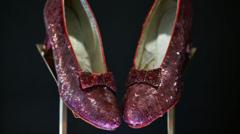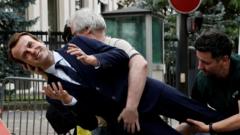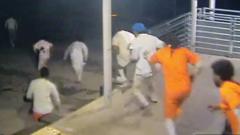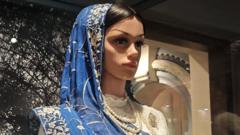A pair of Judy Garland's famous ruby slippers from The Wizard of Oz, once stolen and then recovered, are set to be auctioned off, raising both excitement and questions about their storied past.
Ruby Slippers from The Wizard of Oz Set for Auction

Ruby Slippers from The Wizard of Oz Set for Auction
Iconic memorabilia to fetch up to $3 million as mystery around theft unfolds
The iconic ruby red slippers worn by Judy Garland in the timeless film "The Wizard of Oz" are headed for auction this Saturday, with estimates suggesting they could sell for as much as $3 million. The shimmering shoes, dubbed the "Holy Grail of Hollywood memorabilia" by Heritage Auctions, began online bidding a month ago, which as of Saturday remains at $1.55 million.
Garland was just 16 years old when she captivated audiences as Dorothy in the 1939 musical adaptation of L. Frank Baum's beloved children's book "The Wonderful Wizard of Oz." The film not only became a cherished classic but was also ranked second on Variety's “100 Greatest Movies of All Time.” In a notable change from the book's description of silver slippers, filmmakers opted for striking red to maximize the impact of the new Technicolor technology.
A memorable scene in the film involves Dorothy clicking her heels together three times while proclaiming "There's no place like home," allowing her to leave the enchanting Land of Oz and return to her Auntie Em in Kansas. Though several pairs of the magical footwear were used during filming, only four pairs are confirmed to have survived.
One of those pairs is currently on display at the Smithsonian's National Museum of American History. The ruby slippers slated for auction carry their own fascinating backstory. In 2005, collector Michael Shaw lent them to the Judy Garland Museum in Grand Rapids, Minnesota, but they were stolen in a brazen heist. Professional thief Terry Jon Martin destroyed the display case with a hammer, mistakenly believing the slippers were encrusted with real gemstones due to their insured value.
After attempting to sell the shoes to a jewelry fence, Martin discovered their true nature, made from glass rather than precious gems, and relinquished them. For 13 years, the slippers' whereabouts remained unknown until they were recovered by the FBI in 2018 during a sting operation. Martin, now in his 70s and using a wheelchair, pleaded guilty the following year and received a sentence of time served.
Curator John Kelsch of the Judy Garland Museum expressed a sense of closure regarding the case, albeit accompanied by lingering curiosity about the slippers' mysterious journey during their absence. "It's ludicrous to think he stole them without knowing their true value as an American treasure," Kelsch stated in an interview.
As the auction approaches, anticipation grows not just for the slippers' final bid but also for the untold story that surrounds one of cinema's most iconic artifacts.
Garland was just 16 years old when she captivated audiences as Dorothy in the 1939 musical adaptation of L. Frank Baum's beloved children's book "The Wonderful Wizard of Oz." The film not only became a cherished classic but was also ranked second on Variety's “100 Greatest Movies of All Time.” In a notable change from the book's description of silver slippers, filmmakers opted for striking red to maximize the impact of the new Technicolor technology.
A memorable scene in the film involves Dorothy clicking her heels together three times while proclaiming "There's no place like home," allowing her to leave the enchanting Land of Oz and return to her Auntie Em in Kansas. Though several pairs of the magical footwear were used during filming, only four pairs are confirmed to have survived.
One of those pairs is currently on display at the Smithsonian's National Museum of American History. The ruby slippers slated for auction carry their own fascinating backstory. In 2005, collector Michael Shaw lent them to the Judy Garland Museum in Grand Rapids, Minnesota, but they were stolen in a brazen heist. Professional thief Terry Jon Martin destroyed the display case with a hammer, mistakenly believing the slippers were encrusted with real gemstones due to their insured value.
After attempting to sell the shoes to a jewelry fence, Martin discovered their true nature, made from glass rather than precious gems, and relinquished them. For 13 years, the slippers' whereabouts remained unknown until they were recovered by the FBI in 2018 during a sting operation. Martin, now in his 70s and using a wheelchair, pleaded guilty the following year and received a sentence of time served.
Curator John Kelsch of the Judy Garland Museum expressed a sense of closure regarding the case, albeit accompanied by lingering curiosity about the slippers' mysterious journey during their absence. "It's ludicrous to think he stole them without knowing their true value as an American treasure," Kelsch stated in an interview.
As the auction approaches, anticipation grows not just for the slippers' final bid but also for the untold story that surrounds one of cinema's most iconic artifacts.




















